Ocelot Factory
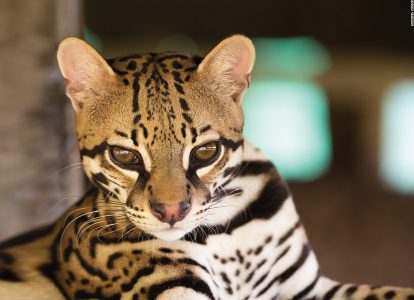
By Jack Ewing
On September 14, 2016, one of the Hacienda Barú guides sent me a photo of an ocelot killed on the coastal highway in front of the Hacienda Barú National Wildlife Refuge. From the spot pattern on its neck and shoulders I was able to identify it as a young male, about two years old, who I had previously named “Frodo”. His identification was made possible by comparing the photo of the dead ocelot with photos and videos of Frodo taken by our trail cameras. Every individual ocelot’s spot pattern is unique, and this facilitates identification. There are tunnels under the highway at Hacienda Barú, and most of the ocelots use them. I assume Frodo had never crossed the highway before and didn’t know about the tunnels.
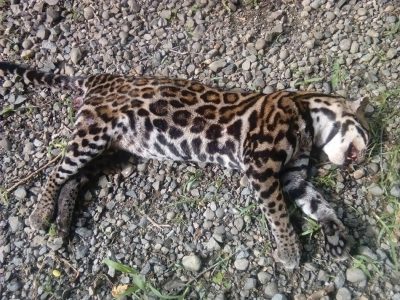 A couple of months earlier a new mature male, an enormous individual who I named “Brutus”, had ousted the male who had reigned for at least three years. I would imagine that Frodo, who was probably a son of the ousted alpha male, and who was approaching reproductive age, felt threatened by Brutus and was forced to leave the territory where he was born and raised. The death of the beautiful, young spotted cat was saddening, but not cause for alarm. There was at least one producing adult female and an immature female, “Tinkerbell”, about a year from reproductive age. There was also quite possibly a second mature producing female within Brutus’ territory. So the death of Frodo wouldn’t have a major impact on the population. We thought.
A couple of months earlier a new mature male, an enormous individual who I named “Brutus”, had ousted the male who had reigned for at least three years. I would imagine that Frodo, who was probably a son of the ousted alpha male, and who was approaching reproductive age, felt threatened by Brutus and was forced to leave the territory where he was born and raised. The death of the beautiful, young spotted cat was saddening, but not cause for alarm. There was at least one producing adult female and an immature female, “Tinkerbell”, about a year from reproductive age. There was also quite possibly a second mature producing female within Brutus’ territory. So the death of Frodo wouldn’t have a major impact on the population. We thought.

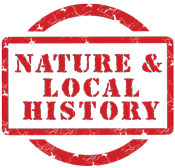 Within the next year four more ocelots were killed on the highways within five kilometers of Hacienda Baru National Wildlife Refuge. This was definitely cause for concern. Why were so many ocelots, being killed on the roads? In May of 2017 a friend sent me a photo of an ocelot killed on the highway near the village of Barú. It appeared to be a young female, but the person who took the photo didn’t pay much attention and reported only seeing a dead ocelot. It would have been helpful to know as much as possible about this road kill—sex, age, size, and physical condition. These simple data could give us clues as to the causes of the elevated level of death on the highways in the area.
Within the next year four more ocelots were killed on the highways within five kilometers of Hacienda Baru National Wildlife Refuge. This was definitely cause for concern. Why were so many ocelots, being killed on the roads? In May of 2017 a friend sent me a photo of an ocelot killed on the highway near the village of Barú. It appeared to be a young female, but the person who took the photo didn’t pay much attention and reported only seeing a dead ocelot. It would have been helpful to know as much as possible about this road kill—sex, age, size, and physical condition. These simple data could give us clues as to the causes of the elevated level of death on the highways in the area.
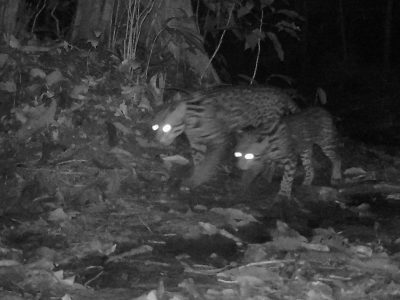 The size of an ocelot’s territory is extremely variable. According to Mark Wainwright’s excellent book, Mammals of Costa Rica, an individual ocelot’s range can vary from 100 hectares (247 acres) to 3,100 hectares (7,660 acres). I would imagine that the difference has to do with the abundance of prey. Ocelots eat primarily small rodents such as spiny rats, though they will also eat larger rodents such as pacas and agoutis, as well as iguanas, small caimans, coatis, raccoons, young peccary, opossums, and many more. In other words they will eat about anything that they can catch and kill. It seems logical that there would be a high density of ocelots in a rainforest with a high level of biodiversity and an abundance of prey. A place such as Hacienda Barú National Wildlife Refuge.
The size of an ocelot’s territory is extremely variable. According to Mark Wainwright’s excellent book, Mammals of Costa Rica, an individual ocelot’s range can vary from 100 hectares (247 acres) to 3,100 hectares (7,660 acres). I would imagine that the difference has to do with the abundance of prey. Ocelots eat primarily small rodents such as spiny rats, though they will also eat larger rodents such as pacas and agoutis, as well as iguanas, small caimans, coatis, raccoons, young peccary, opossums, and many more. In other words they will eat about anything that they can catch and kill. It seems logical that there would be a high density of ocelots in a rainforest with a high level of biodiversity and an abundance of prey. A place such as Hacienda Barú National Wildlife Refuge.
Between September 7 and October 10, 2017 the Hacienda Barú trail cameras in the highland rainforest captured photos of four different ocelot individuals: a mature female with a large cub, a young female about two-years-old who I call “Tinkerbell”, and another unknown individual whose sex we were unable to determine from the photos.
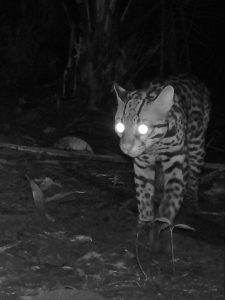 During the same period one of the lowland cameras, near the beach captured a photo of a large cub less than a year old. I had seen this cub and a litter mate with their mother in previous months and am reasonably sure that they are all still in the area. If so, that means that our trail cameras captured photos of five different individuals on 330 hectare (815 acre) Hacienda Barú National Wildlife Refuge in one month, and there are quite possibly two more. That is much higher than normal density. Apparently the death toll from crossing the highway isn’t having much impact on the ocelot population. In fact the high density of ocelots is very likely one of the primary factors influencing the exit of some individuals from the area thus resulting in an elevated amount of road kill. Young animals, feeling the pressure from the large number of competitors, are leaving the territories where they were born and raised, and some of them are being killed on the highways. We needn’t worry so much that these deaths are negatively affecting the population, rather it is over population that is forcing them to leave the relative safety of the rainforest to look for new territories. After seeing all of the ocelot photos from September-October I commented jokingly that we must have an ocelot factory at Hacienda Barú.
During the same period one of the lowland cameras, near the beach captured a photo of a large cub less than a year old. I had seen this cub and a litter mate with their mother in previous months and am reasonably sure that they are all still in the area. If so, that means that our trail cameras captured photos of five different individuals on 330 hectare (815 acre) Hacienda Barú National Wildlife Refuge in one month, and there are quite possibly two more. That is much higher than normal density. Apparently the death toll from crossing the highway isn’t having much impact on the ocelot population. In fact the high density of ocelots is very likely one of the primary factors influencing the exit of some individuals from the area thus resulting in an elevated amount of road kill. Young animals, feeling the pressure from the large number of competitors, are leaving the territories where they were born and raised, and some of them are being killed on the highways. We needn’t worry so much that these deaths are negatively affecting the population, rather it is over population that is forcing them to leave the relative safety of the rainforest to look for new territories. After seeing all of the ocelot photos from September-October I commented jokingly that we must have an ocelot factory at Hacienda Barú.
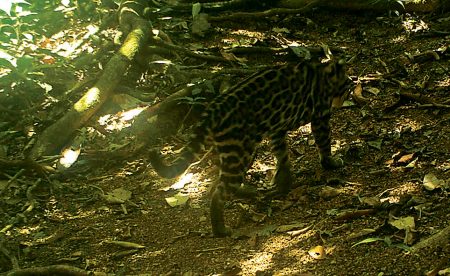 Much of the above, of course, is pure speculation. You might call it an educated guess. We would prefer to determine the reasons for the large number of ocelot deaths on the highways through scientific research. At the moment Hacienda Baru National Wildlife Refuge is in conversations with the environmental organization Nãi Conservation about working together to study the ocelots in hopes of better understanding their biology and behavior at Hacienda Barú and in the Path of the Tapir Biological Corridor. Nãi is a great group, and we look forward to working with them. Their web page naiconservation.org is currently under construction, but they have a wonderful Facebook page.
Much of the above, of course, is pure speculation. You might call it an educated guess. We would prefer to determine the reasons for the large number of ocelot deaths on the highways through scientific research. At the moment Hacienda Baru National Wildlife Refuge is in conversations with the environmental organization Nãi Conservation about working together to study the ocelots in hopes of better understanding their biology and behavior at Hacienda Barú and in the Path of the Tapir Biological Corridor. Nãi is a great group, and we look forward to working with them. Their web page naiconservation.org is currently under construction, but they have a wonderful Facebook page.
If any of you readers see a dead wild feline of any kind on the road, please stop and take a photo. Try to estimate the age of the animal (infant, immature, adult, old). Looking at the teeth is a good way to get an idea of the age. You all know what old teeth look like. The sex of the animal is also important. If possible take a photo of the genital area. The size is important as well. If you don’t have a tape measure put something of known size in the photo near the dead animal. A human hand or a sheet of paper (letter size) will be fine, but don’t cover any of the animal’s body where there may be spots or marks that can be used to identify the individual. The animal’s physical condition is a good indicator of its state of health. Does it look fat and well fed, or is it thin and scraggly? Then send the photos and information to me at jack@haciendabaru.com We will be very thankful for your cooperation in the research project. Your information is extremely helpful.
